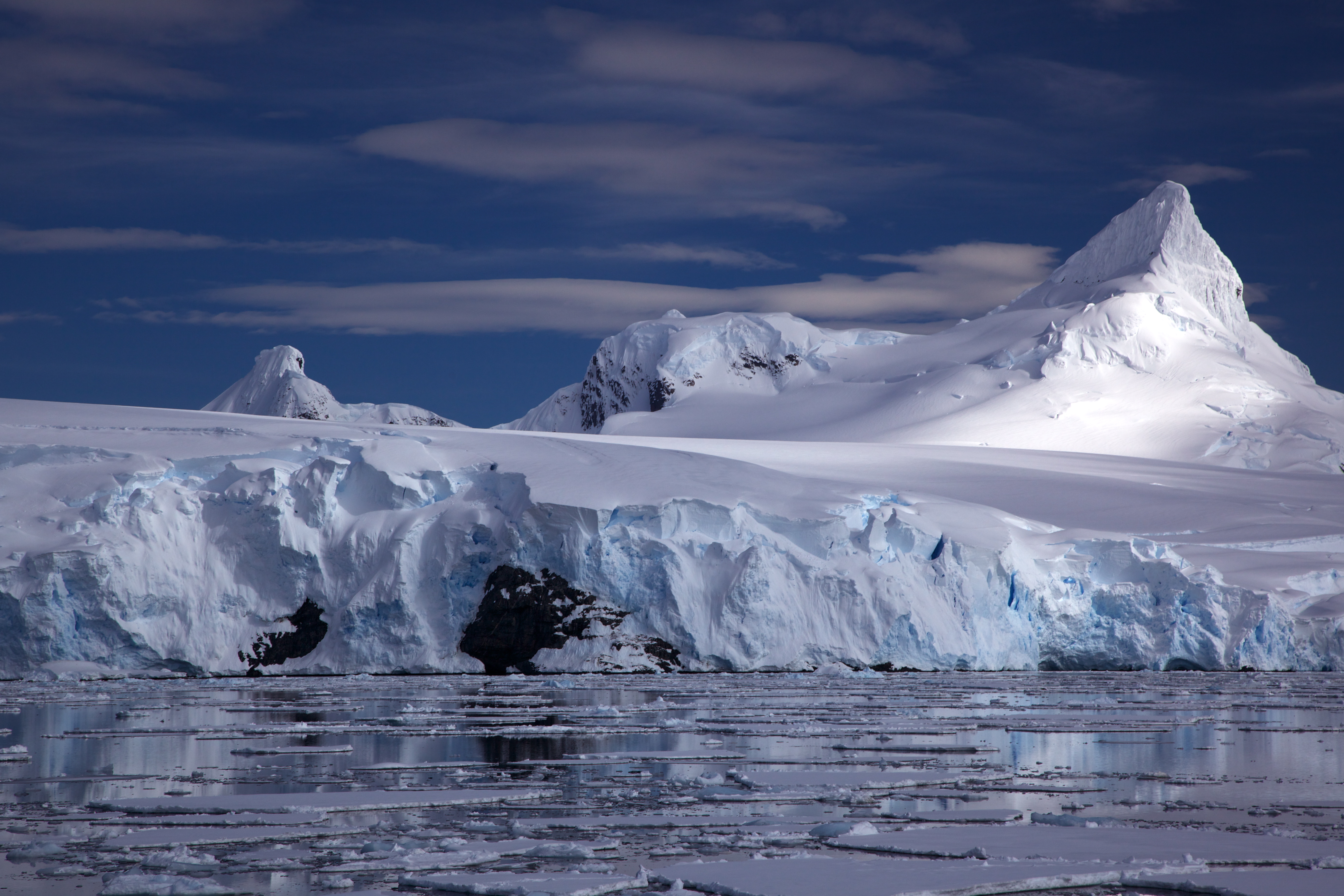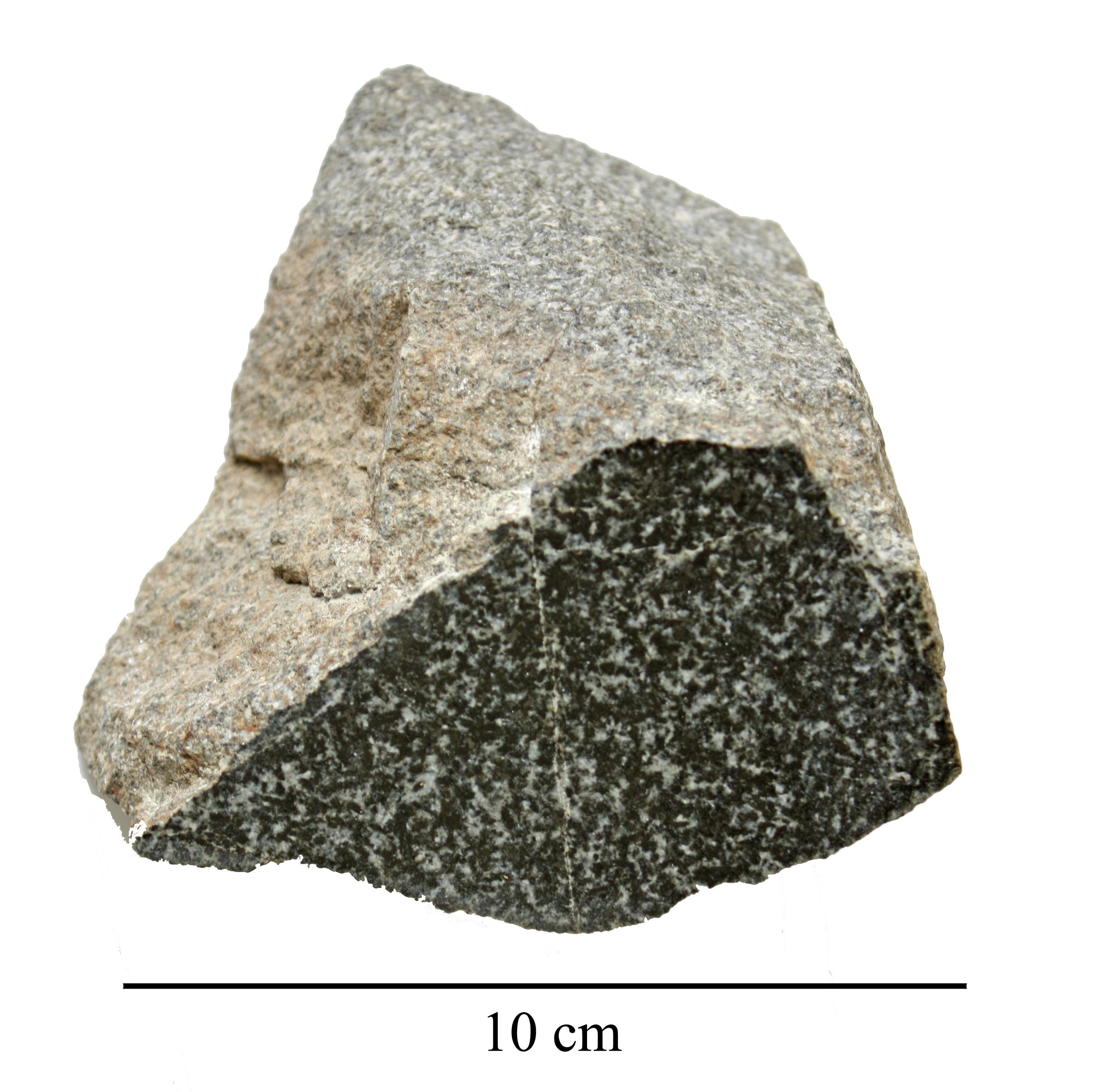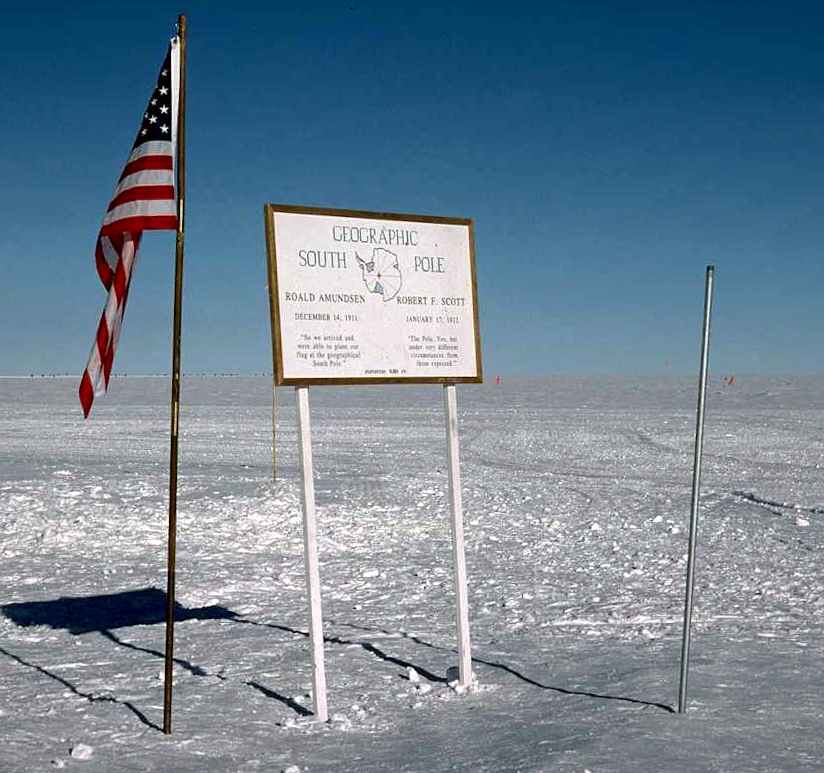|
Axel Heiberg Glacier
The Axel Heiberg Glacier in Antarctica is a valley glacier, long, descending from the high elevations of the Antarctic Plateau into the Ross Ice Shelf (nearly at sea level) between the Herbert Range and Mount Don Pedro Christophersen in the Queen Maud Mountains. This huge glacier was discovered in November 1911 by the Norwegian polar explorer Roald Amundsen, and named by him for Axel Heiberg, a Norwegian businessman and patron of science who contributed to numerous Norwegian polar expeditions. Amundsen used this glacier as his route up onto the polar plateau during his successful expedition to the South Pole. Unlike the big “outlet” glaciers such as the Beardmore, Shackleton and Liv, the Axel Heiberg is in effect an alpine glacier, cut off from the Plateau by a dolerite rim and fed entirely from the uncharacteristically heavy snow falling within its own catchment. It falls over 2,700 m (9,000 ft) in 32 km (20 mi), most of it over 11 km (7 mi). See also * List o ... [...More Info...] [...Related Items...] OR: [Wikipedia] [Google] [Baidu] |
Queen Maud Mountains
The Queen Maud Mountains are a major group of mountains, ranges and subordinate features of the Transantarctic Mountains, lying between the Beardmore and Reedy Glaciers and including the area from the head of the Ross Ice Shelf to the Antarctic Plateau in Antarctica. Captain Roald Amundsen and his South Pole party ascended Axel Heiberg Glacier near the central part of this group in November 1911, naming these mountains for the Norwegian queen Maud of Wales. Despite the name, they are not located within Queen Maud Land. Elevations bordering the Beardmore Glacier, at the western extremity of these mountains, were observed by the British expeditions led by Ernest Shackleton (1907–09) and Robert Falcon Scott (1910-13), but the mountains as a whole were mapped by several American expeditions led by Richard Evelyn Byrd (1930s and 1940s), and United States Antarctic Program (USARP) and New Zealand Antarctic Research Program (NZARP) expeditions from the 1950s through the 1970s. ... [...More Info...] [...Related Items...] OR: [Wikipedia] [Google] [Baidu] |
Norway
Norway, officially the Kingdom of Norway, is a Nordic country in Northern Europe, the mainland territory of which comprises the western and northernmost portion of the Scandinavian Peninsula. The remote Arctic island of Jan Mayen and the archipelago of Svalbard also form part of Norway. Bouvet Island, located in the Subantarctic, is a dependency of Norway; it also lays claims to the Antarctic territories of Peter I Island and Queen Maud Land. The capital and largest city in Norway is Oslo. Norway has a total area of and had a population of 5,425,270 in January 2022. The country shares a long eastern border with Sweden at a length of . It is bordered by Finland and Russia to the northeast and the Skagerrak strait to the south, on the other side of which are Denmark and the United Kingdom. Norway has an extensive coastline, facing the North Atlantic Ocean and the Barents Sea. The maritime influence dominates Norway's climate, with mild lowland temperatures on the ... [...More Info...] [...Related Items...] OR: [Wikipedia] [Google] [Baidu] |
Glaciology
Glaciology (; ) is the scientific study of glaciers, or more generally ice and natural phenomena that involve ice. Glaciology is an interdisciplinary Earth science that integrates geophysics, geology, physical geography, geomorphology, climatology, meteorology, hydrology, biology, and ecology. The impact of glaciers on people includes the fields of human geography and anthropology. The discoveries of water ice on the Moon, Mars, Europa and Pluto add an extraterrestrial component to the field, which is referred to as "astroglaciology". Overview A glacier is an extended mass of ice formed from snow falling and accumulating over a long period of time; glaciers move very slowly, either descending from high mountains, as in valley glaciers, or moving outward from centers of accumulation, as in continental glaciers. Areas of study within glaciology include glacial history and the reconstruction of past glaciation. A glaciologist is a person who studies glaciers. A glaci ... [...More Info...] [...Related Items...] OR: [Wikipedia] [Google] [Baidu] |
List Of Glaciers In The Antarctic
There are many glaciers in the Antarctic. This set of lists does not include ice sheets, ice caps or ice fields, such as the Antarctic ice sheet, but includes glacial features that are defined by their flow, rather than general bodies of ice. The lists include outlet glaciers, valley glaciers, cirque glaciers, tidewater glaciers and ice streams. Ice streams are a type of glacier and many of them have "glacier" in their name, e.g. Pine Island Glacier. Ice shelves are listed separately in the List of Antarctic ice shelves. For the purposes of these lists, the Antarctic is defined as any latitude further south than 60° (the continental limit according to the Antarctic Treaty System). List by letters * List of glaciers in the Antarctic: A–H * List of glaciers in the Antarctic: I–Z See also * List of Antarctic and subantarctic islands * List of Antarctic ice rises * List of Antarctic ice shelves This is a list of Antarctic ice shelves. Ice shelves ar ... [...More Info...] [...Related Items...] OR: [Wikipedia] [Google] [Baidu] |
Diabase
Diabase (), also called dolerite () or microgabbro, is a mafic, holocrystalline, subvolcanic rock equivalent to volcanic basalt or plutonic gabbro. Diabase dikes and sills are typically shallow intrusive bodies and often exhibit fine-grained to aphanitic chilled margins which may contain tachylite (dark mafic glass). ''Diabase'' is the preferred name in North America, while ''dolerite'' is the preferred name in the rest of the English-speaking world, where sometimes the name ''diabase'' refers to altered dolerites and basalts. Some geologists prefer to avoid confusion by using the name ''microgabbro''. The name ''diabase'' comes from the French ', and ultimately from the Greek - meaning "act of crossing over, transition". Petrography Diabase normally has a fine but visible texture of euhedral lath-shaped plagioclase crystals (62%) set in a finer matrix of clinopyroxene, typically augite (20–29%), with minor olivine (3% up to 12% in olivine diabase), magnetit ... [...More Info...] [...Related Items...] OR: [Wikipedia] [Google] [Baidu] |
Liv Glacier
Liv Glacier is a steep valley glacier, long, emerging from the Antarctic Plateau just southeast of Barnum Peak and draining north through the Queen Maud Mountains to enter Ross Ice Shelf between Mayer Crags and Duncan Mountains. It was discovered in 1911 by Roald Amundsen, who named it for the daughter of Fridtjof Nansen. The airway above the Liv Glacier was used by the monoplane ''Floyd Bennett'' in 1929 as the route for the first journey to the South Pole The South Pole, also known as the Geographic South Pole, Terrestrial South Pole or 90th Parallel South, is one of the two points where Earth's axis of rotation intersects its surface. It is the southernmost point on Earth and lies antipod ... by air. We have investigated the geochemistry of supraglacial streams on the Canada Glacier, Taylor Valley, Antarctica during the 2001–2002 austral summer. Canada Glacier supraglacial streams represent the link between primary precipitation (i.e. glacier snow) and proglacial ... [...More Info...] [...Related Items...] OR: [Wikipedia] [Google] [Baidu] |
Shackleton Glacier
Shackleton Glacier is a major Antarctic glacier, over long and from 8 to 16 km (5 to 10 mi) wide, descending from the polar plateau from the vicinity of Roberts Massif and flowing north through the Queen Maud Mountains to enter the Ross Ice Shelf between Mount Speed and Waldron Spurs. The Roberts Zealand GSAE (1961–62), who named it for A.R. Roberts, leader at Scott Massif is a remarkable snow-free massif exceeding 2,700 metres (8,860 ft) and about 155 km2 (60 sq mi) in area. It was by the Southern Party of New USAS (1939–41) and named by US-SCAN for Sir Ernest Shackleton, Anglo-Irish Antarctic explorer. See also * List of glaciers in the Antarctic * Mount Greenlee Mount Greenlee () is a steep-sided, jagged mountain in Antarctica, high; of metamorphic rock, it overlooks the west side of Shackleton Glacier just east of Mount Butters. It was named by F. Alton Wade, leader of the Texas Tech Shackleton Glacier ... References * * Queen Maud Mountai ... [...More Info...] [...Related Items...] OR: [Wikipedia] [Google] [Baidu] |
Beardmore Glacier
The Beardmore Glacier in Antarctica is one of the largest valley glaciers in the world, being long and having a width of . It descends about from the Antarctic Plateau to the Ross Ice Shelf and is bordered by the Commonwealth Range of the Queen Maud Mountains on the eastern side and the Queen Alexandra Range of the Central Transantarctic Mountains on the western. The glacier is one of the main passages through the Transantarctic Mountains to the great polar plateau beyond, and was one of the early routes to the South Pole despite its steep upward incline. The glacier was discovered and climbed by Ernest Shackleton during his ''Nimrod'' Expedition of 1908. Although Shackleton turned back at latitude 88° 23' S, just from the South Pole, he established the first proven route towards the pole and, in doing so, became the first person to set foot upon the polar plateau. In 1911–1912, Captain Scott and his ''Terra Nova'' Expedition team reached the South Pole by ... [...More Info...] [...Related Items...] OR: [Wikipedia] [Google] [Baidu] |
South Pole
The South Pole, also known as the Geographic South Pole, Terrestrial South Pole or 90th Parallel South, is one of the two points where Earth's axis of rotation intersects its surface. It is the southernmost point on Earth and lies antipodally on the opposite side of Earth from the North Pole, at a distance of 12,430 miles (20,004 km) in all directions. Situated on the continent of Antarctica, it is the site of the United States Amundsen–Scott South Pole Station, which was established in 1956 and has been permanently staffed since that year. The Geographic South Pole is distinct from the South Magnetic Pole, the position of which is defined based on Earth's magnetic field. The South Pole is at the centre of the Southern Hemisphere. Geography For most purposes, the Geographic South Pole is defined as the southern point of the two points where Earth's axis of rotation intersects its surface (the other being the Geographic North Pole). However, Earth's axis of rota ... [...More Info...] [...Related Items...] OR: [Wikipedia] [Google] [Baidu] |
Axel Heiberg
Axel Heiberg (16 March 1848 – 4 September 1932) was a Norwegian diplomat and financier as well as a patron of the arts and sciences. Biography Heiberg was born in Kristiania (now Oslo), Norway. He was the son of Johan Fritzner Heiberg (1805–1883) and Emma Wilhelmine Munch (1818–1888). His father was a professor at the University of Kristiania and general surgeon in the Norwegian Army. Heiberg studied abroad and was for a period Norwegian consul in China. He returned to Norway where in 1876 together with the brothers Amund Ringnes and Ellef Ringnes he financed the creation of the Ringnes brewery. Together with shipping magnate Thomas Fearnley, the brewery sponsored the polar expeditions of Fridtjof Nansen and Otto Sverdrup, and funded the construction of the exploration vessel '' Fram''. This led to Heiberg's name being given to Axel Heiberg Island in Canada, the Axel Heiberg Glacier in Antarctica as well as Heiberg Islands in Siberia. In 1878 Heiberg was one of the ... [...More Info...] [...Related Items...] OR: [Wikipedia] [Google] [Baidu] |
Antarctica
Antarctica () is Earth's southernmost and least-populated continent. Situated almost entirely south of the Antarctic Circle and surrounded by the Southern Ocean, it contains the geographic South Pole. Antarctica is the fifth-largest continent, being about 40% larger than Europe, and has an area of . Most of Antarctica is covered by the Antarctic ice sheet, with an average thickness of . Antarctica is, on average, the coldest, driest, and windiest of the continents, and it has the highest average elevation. It is mainly a polar desert, with annual precipitation of over along the coast and far less inland. About 70% of the world's freshwater reserves are frozen in Antarctica, which, if melted, would raise global sea levels by almost . Antarctica holds the record for the lowest measured temperature on Earth, . The coastal regions can reach temperatures over in summer. Native species of animals include mites, nematodes, penguins, seals and tardigrades. Where ve ... [...More Info...] [...Related Items...] OR: [Wikipedia] [Google] [Baidu] |
Roald Amundsen
Roald Engelbregt Gravning Amundsen (, ; ; 16 July 1872 – ) was a Norwegians, Norwegian explorer of polar regions. He was a key figure of the period known as the Heroic Age of Antarctic Exploration. Born in Borge, Østfold, Norway, Amundsen began his career as a polar explorer as first mate on Adrien de Gerlache's Belgian Antarctic Expedition of 1897–1899. From 1903 to 1906, he led the first expedition to successfully traverse the Northwest Passage on the sloop ''Gjøa''. In 1909, Amundsen began planning for a Amundsen's South Pole expedition, South Pole expedition. He left Norway in June 1910 on the ship ''Fram (ship), Fram'' and reached Antarctica in January 1911. His party established a Framheim, camp at the Bay of Whales and a series of supply depots on the Barrier (now known as the Ross Ice Shelf) before setting out for the pole in October. The party of five, led by Amundsen, became the first to successfully Amundsen's South Pole expedition, reach the South Pole o ... [...More Info...] [...Related Items...] OR: [Wikipedia] [Google] [Baidu] |







